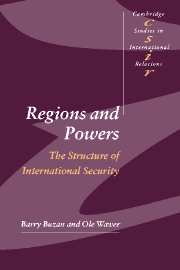Book contents
- Frontmatter
- Contents
- List of illustrations
- Preface
- List of abbreviations
- 1 Patterns of regional security during the Cold War
- 2 Patterns of regional security post-Cold War
- Part I Introduction: developing a regional approach to global security
- Part II Asia
- Introduction
- 4 South Asia: inching towards internal and external transformation
- 5 Northeast and Southeast Asian RSCs during the Cold War
- 6 The 1990s and beyond: an emergent East Asian complex
- Conclusions: scenarios for the Asian supercomplex
- Part III The Middle East and Africa
- Part IV The Americas
- Part V The Europes
- Part VI Conclusions
- Glossary
- References
- News media
- Index of names
- General Index
- CAMBRIDGE STUDIES IN INTERNATIONAL RELATIONS
6 - The 1990s and beyond: an emergent East Asian complex
Published online by Cambridge University Press: 05 December 2009
- Frontmatter
- Contents
- List of illustrations
- Preface
- List of abbreviations
- 1 Patterns of regional security during the Cold War
- 2 Patterns of regional security post-Cold War
- Part I Introduction: developing a regional approach to global security
- Part II Asia
- Introduction
- 4 South Asia: inching towards internal and external transformation
- 5 Northeast and Southeast Asian RSCs during the Cold War
- 6 The 1990s and beyond: an emergent East Asian complex
- Conclusions: scenarios for the Asian supercomplex
- Part III The Middle East and Africa
- Part IV The Americas
- Part V The Europes
- Part VI Conclusions
- Glossary
- References
- News media
- Index of names
- General Index
- CAMBRIDGE STUDIES IN INTERNATIONAL RELATIONS
Summary
Unlike in South Asia, where the ending of the Cold War did not make much difference to the regional security dynamics, in East Asia it made a big difference. In Southeast Asia the withdrawal of Soviet power and the pulling back of US forces facilitated the shift away from a conflictual bipolarisation and towards a security regime. In Northeast Asia, the confrontation on the Korean peninsula continued, and Japan chose to remain a subordinate partner of the United States. The military confrontation of the Cold War dropped away, but only to give more freedom of action to China, whose weight in the region was increasing rapidly. This encouraged the local states to begin relinking their security affairs on an East Asian scale. The main argument in this chapter is that, by giving more weight to China, the ending of the Cold War opened the way for an external transformation in the regional security architecture of East Asia. From the 1980s economically, and during the 1990s also in a military-political sense, the states of Northeast and Southeast Asia increasingly began to merge into a single RSC. A benchmark date to signal the before and after points of this merger could be 1994–5, when the ASEAN Regional Forum (ARF) was set up, and Vietnam joined ASEAN. This merger had both historical precedents and Cold War precursors as sketched above.
- Type
- Chapter
- Information
- Regions and PowersThe Structure of International Security, pp. 144 - 171Publisher: Cambridge University PressPrint publication year: 2003

